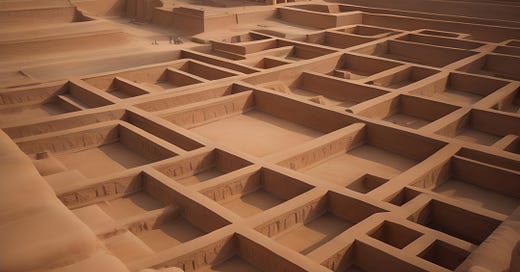The Mysteries of Mohenjo-Daro: Unraveling the Enigma of an Ancient Civilization
"Unveiling the Secrets of Mohenjo-Daro: A Deep Dive into the Enigmatic Indus Valley Civilization | Ancient Wonders Newsletter"
Welcome to another edition of Ancient Wonders, your window into the fascinating world of ancient history and archaeology. In this installment, we embark on a journey to unlock the secrets of one of the most enigmatic civilizations in history - Mohenjo-Daro.
Introduction
The ancient city of Mohenjo-Daro, located in what is now modern-day Pakistan, is a testament to human ingenuity and innovation. Its ruins stand as a silent witness to a civilization that thrived over 4,000 years ago, yet still perplexes historians and archaeologists with its many mysteries. In this article, we will delve deep into the mysteries of Mohenjo-Daro, exploring its history, urban planning, culture, and the questions that continue to baffle experts.
The Discovery of Mohenjo-Daro
Before we dive into the mysteries, let's start with the basics. Mohenjo-Daro was discovered in the early 20th century by British archaeologist Sir John Marshall. The name Mohenjo-Daro itself means "Mound of the Dead," and it was one of the major settlements of the Indus Valley Civilization, which existed from approximately 3300 BCE to 1300 BCE.
The city is located in what is now the Sindh province of Pakistan, near the Indus River. At its peak, it was one of the most advanced urban centers of its time, boasting impressive architectural structures and a highly organized layout.
The Mysterious Urban Planning
One of the first mysteries of Mohenjo-Daro lies in its urban planning and architecture. The city was designed with a grid-like street layout, featuring wide, well-organized streets, and sophisticated drainage systems. The houses had multiple stories, advanced plumbing systems, and even what appear to be private baths.
The level of urban planning and engineering in Mohenjo-Daro rivals that of some modern cities, leaving archaeologists to wonder how a civilization so ancient could have achieved such advanced urban development. The city's well-thought-out infrastructure has led to speculations about its governance and the existence of a central authority, yet little concrete evidence has been found to support these theories.
The Undecipherable Script
One of the most frustrating and enduring mysteries of Mohenjo-Daro is the script used by its inhabitants. While the city's extensive ruins have yielded thousands of inscriptions, experts have been unable to decipher the script. Known as the Indus script, it consists of a series of symbols and characters that appear on seals, pottery, and other artifacts.
Despite the best efforts of linguists and epigraphers, the script remains undeciphered to this day. Is it a form of writing, a religious script, or simply decorative symbols? The enigma of the Indus script continues to tantalize scholars, as its decipherment could provide invaluable insights into the culture, beliefs, and daily life of the Mohenjo-Daro people.
The Great Bath and Religious Significance
Another intriguing feature of Mohenjo-Daro is the Great Bath, a large, rectangular pool surrounded by a veranda. This structure has led to debates about its purpose and religious significance. Some experts believe it was used for ritual purification, while others suggest it might have served a communal or recreational purpose.
The presence of this impressive bath raises questions about the religious and spiritual practices of the Indus Valley Civilization. Did they have a well-defined religious pantheon or a specific belief system? The answers remain elusive, and the Great Bath remains a symbol of the mysteries surrounding Mohenjo-Daro.
The Disappearance of the Indus Valley Civilization
Perhaps the most significant mystery surrounding Mohenjo-Daro and its sister cities in the Indus Valley Civilization is the reason for their decline and eventual disappearance. Around 1900 BCE, these once-thriving cities began to decline, and by 1300 BCE, they had all but vanished.
Theories abound regarding the civilization's demise. Some suggest environmental factors, such as changes in the course of the Indus River, while others propose invasions by outside forces. Yet, despite these theories, the precise cause of the civilization's collapse remains speculative.
It's important to note that the Indus Valley Civilization's disappearance is not solely a mystery but also a tragedy, as it marks the end of a remarkable chapter in human history.
Conclusion
Mohenjo-Daro, the jewel of the Indus Valley Civilization, continues to captivate our imaginations and confound our understanding of ancient civilizations. Its advanced urban planning, undecipherable script, and enigmatic disappearance all contribute to its mystique.
As we continue to uncover the secrets of this ancient city, one thing becomes clear: the more we learn about Mohenjo-Daro, the more questions we have. It is a testament to the enduring allure of archaeology and the limitless capacity for human curiosity.
In the coming years, as archaeologists and historians uncover more evidence and refine their methods, we may inch closer to unraveling the mysteries of Mohenjo-Daro. Until then, we can only marvel at the achievements of this ancient civilization and eagerly anticipate the next discovery that might shed light on its secrets.
Thank you for joining us in this exploration of The Mysteries of Mohenjo-Daro. Stay tuned for more fascinating insights into the wonders of the ancient world in future editions of Ancient Wonders.




